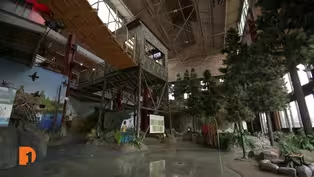
Michigan Central Station reopens after historic renovation
Clip: Season 9 Episode 1 | 5m 3sVideo has Closed Captions
Michigan Central Station reopens to the public after a six-year restoration process.
For three decades, Michigan Central Station sat vacant in Detroit’s Corktown neighborhood, falling into deep decay. After a six-year renovation spearheaded by Ford Motor Company, the station reopened to the public June 6, 2024. One Detroit’s Will Glover and Chris Jordan toured the newly restored station and show its historic transformation.
Problems playing video? | Closed Captioning Feedback
Problems playing video? | Closed Captioning Feedback
One Detroit is a local public television program presented by Detroit PBS

Michigan Central Station reopens after historic renovation
Clip: Season 9 Episode 1 | 5m 3sVideo has Closed Captions
For three decades, Michigan Central Station sat vacant in Detroit’s Corktown neighborhood, falling into deep decay. After a six-year renovation spearheaded by Ford Motor Company, the station reopened to the public June 6, 2024. One Detroit’s Will Glover and Chris Jordan toured the newly restored station and show its historic transformation.
Problems playing video? | Closed Captioning Feedback
How to Watch One Detroit
One Detroit is available to stream on pbs.org and the free PBS App, available on iPhone, Apple TV, Android TV, Android smartphones, Amazon Fire TV, Amazon Fire Tablet, Roku, Samsung Smart TV, and Vizio.
Providing Support for PBS.org
Learn Moreabout PBS online sponsorship(upbeat music) For three decades, the Michigan Central train station sat vacant in Detroit, falling into deep decay.
Then in 2018, Ford Motor Company purchased the station.
Ford invited "One Detroit" to Corktown to see the transformation Michigan Central Station has undergone.
- Everything has been restored to, as best possible, to what its original condition is.
Often talk now about that the building is, in some ways, in its most pristine condition, in some ways, ever.
- We took out 3.5 million gallons of water from the station over the first 18 months.
Most of that water was in the basement, but some of it just ran inside into various rooms and over the columns like this, that led to this sort of wonderful grooved feeling.
- [Narrator] That feeling captures the station's history, spanning more than a century.
- The station was originally designed by the same architects who did New York's Grand Central Station.
- Building started occupancy in 1913.
The station last passenger rail stopped in 1988, then, you know, sat vacant for 36 years.
- [Narrator] The clock position between the Grand Hall and the South Concourse is a prime example of how the restoration aims to merge the past and present.
- This historic clock was able to be reproduced because we had original components from the clock itself.
Not the entirety of it, but components of it.
And then working with those historic wood pieces plus the original drawings, we were able to recreate the beautiful clock that will keep us on track as we move forward into the next century.
- This portion of the arcade here will be activated with experiential retail, food and beverage.
Things like that will start in the fall, with activity like that happening in the building.
- [Narrator] When you approach the station from the park and make your way through the main entry doors, you'll be greeted by the Grand Hall.
- [Josh] Grand Hall is obviously not just probably the most spectacular space here in Detroit, but certainly one of them in the country, if not the world.
- It was lined with oak benches that were inset into the floor here.
And you can see remnants of those and what they were.
This sort of Guastavino tiled, arched ceiling is magnificent.
It is clay tile, and there's 29,000 tiles up there.
And that's over eight miles of grout.
- [Narrator] When the station was purchased, the Grand Hall's windows were inoperable.
The cast iron rosettes and filigrees flanking the windows were removed or decayed.
The few that were salvaged were 3D scanned and printed at the Ford Manufacturing Lab.
Before the last stop on our tour, we made our way to the South Concourse.
On its surface, it's almost identical to the way it looked in the 1940s, when it serviced nearly 4,000 people a day.
But below its surface is modern technology.
- We have, for example, in here, in floor cooling as part of how we will heat and cool this vast space.
- We also, in the selection of glass throughout, worked on selecting the Wright types of glass to reduce cooling loads.
And so the building is going to be a really future-forward, managed machine to keep these sort of costs low and be the most sustainable as possible.
- [Narrator] Amid the Restoration, Ford set out to honor the station's heyday, but also the time it sat vacant.
One example is the graffiti on station walls.
- It's also an important chapter in the building's history.
In other cases, we've preserved some of the work itself.
Not connected to the walls anymore, but we will figure out how and where we can exhibit those or incorporate them into the design of spaces within the building.
- Has there been thought given to how everything that's going on here is gonna be impacting the greater area, the businesses around here, the neighborhoods around here, the people who've been here?
- We have extensive relationships with communities around us, on all sides, and extensive relationships with the business community.
We are very proud of generating a robust amount of business for local businesses.
- [Narrator] Part of the goal for Michigan Central Station's revival is to be a global example of what major projects like this can be to the people and places around them.
- We want this to be an epicenter of talent, of innovation, of thought, of leadership, that pulls together creators, community, innovators, leaders, you name it, into what is really a model for elsewhere and unique.
And not just unique in the Detroit context, but in a national one and international context.
CCH Pounder’s ‘Double ID’ exhibit at The Wright Museum
Video has Closed Captions
Clip: S9 Ep1 | 7m 11s | The Wright Museum opens the “Double ID” exhibit from actress and art collector CCH Pounder. (7m 11s)
Ford Piquette Avenue Plant Museum preserves Detroit history
Video has Closed Captions
Clip: S9 Ep1 | 5m 2s | The Ford Piquette Avenue Plant Museum is working to preserve Detroit’s automotive history. (5m 2s)
Outdoor Adventure Center brings Michigan’s outdoors inside
Video has Closed Captions
Clip: S9 Ep1 | 4m 21s | Outdoor Adventure Center brings Michigan’s outside in to experience nature and recreation. (4m 21s)
Providing Support for PBS.org
Learn Moreabout PBS online sponsorship
- News and Public Affairs

Top journalists deliver compelling original analysis of the hour's headlines.

- News and Public Affairs

FRONTLINE is investigative journalism that questions, explains and changes our world.












Support for PBS provided by:
One Detroit is a local public television program presented by Detroit PBS


